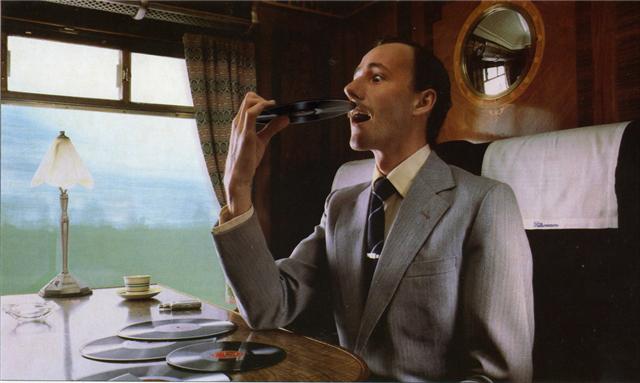Hong Kong-style milk tea is made of a mix of several types of black tea (the proportion of which is usually a "commercial secret" for famous milk tea vendors), evaporated milk, and sugar, the last of which is added by the customers themselves unless in the case of take-away. The use of condensed milk instead of milk and sugar, gives the tea a richer feel, and some Hong Kong eateries further thicken the taste by stirring in a raw egg just before serving (when the tea isn't so hot that it will cook the egg into solid). The common advertising catchphrase for milk tea in Hong Kong is "Ceylon black tea with Holland Black & White evaporated milk".
To make the tea, water and tea (about 1 to 3 teaspoons of tea a cup, depending how strong the drinker likes) are brought to a boil then simmered for about 3-6 minutes. The tea is usually put in a sackcloth bag before the water is added to the pot to filter it out or if no bag available poured through a strainer. Many people also remove the pot from the heat once it boils for about 3 minutes, then bring the pot to a boil again. This process can be repeated several times, intensifying the caffeine/flavor.
The key feature of Hong Kong-style milk tea is that a sackcloth bag is used to filter the tea leaves. However any other filter/strainer may be used to filter the tea. Sackcloth bags are not completely necessary but generally preferred. The bag, reputed to make the tea smoother, gradually develops an intense brown colour as a result of prolonged tea drenching. Together with the shape of the filter, it resembles a pantyhose, giving Hong Kong-style milk tea the nickname of "pantyhose" or "silk stocking" milk tea (Chinese: 絲襪奶茶). This nickname is used in Hong Kong but less so in mainland China and overseas communities.
There are debates over the authentic way of making milk tea, i.e. the sequence of adding each. Some people argue that milk should be added before pouring the tea, while some hold the opposite view. Most people do agree that both ways are authentic. In the past, however, milk tea were usually made in the tea-after-milk way. It is said that the cups may break when the tea (which can be as hot as 80–90 degree Celsius) is poured. There is also a saying that the milk is sterilized when the tea is added.
[edit] Culinary culture
Hot milk tea in a coffee cup accompanies a breakfast
Milk tea is a popular part of many Hong Kongers' daily lives, typically served as part of afternoon tea, but also at breakfast or dinner. It enjoys nearly the same ubiquitous status that coffee holds in the West. Whilst not offered by more traditional Cantonese restaurants or dim sum teahouses, milk tea is standard fare in Hong Kong-style western restaurants and cha chaan tengs, as well as Hong Kong's historic dai pai dongs, with a price between HKD$8–$12 (hot, one or two dollars more for cold). A cup of hot milk tea is usually either served in a ceramic cup (often referred to as a "coffee cup" 咖啡杯) or a tall cylindrical plastic glass.
In contrast, some expatriate Westerners and tourists may not hold milk tea in as high regard. The 2006 edition of the Rough Guide to Hong Kong and Macau[1] by Jules Brown and David Leffman compares the local milk tea unfavourably with "proper" English tea served in more formal Western cafes and hotels such as the Peninsula Hotel, citing different cultural preferences. In the Lonely Planet World Food Hong Kong[2] guide by Richard Sterling and Elizabeth Chong, traditional Chinese tea and high teas in hotels are favoured over milk tea, which is not mentioned at all.
[edit] Criteria for quality milk tea
The first criterion of a good cup of milk tea is its "smoothness" (香滑); in other words, how creamy and full-bodied it is.
Another criterion for tasty milk tea (and also bubble tea) is some white frothy residue inside the lip of the cup after some of it has been drunk. This white froth means that the concentration of butterfat in the evaporated milk used is high enough.
[edit] Varieties
Today, iced milk tea is usually prepared with ice cubes. However, in the old days, when machines for producing ice cubes were not popular, the iced milk tea was made by filling the hot milk tea into a glass bottle and then cooling it in a fridge. Sometimes the milk tea were filled in Vitasoy or Coca-Cola bottles, and were sold by bottle. Today this type of "bottle milk tea" is rare in Hong Kong. Iced milk tea in cans or plastic bottles can be found in many of the convenience stores around Hong Kong such as 7-11 and Circle K.
In the case of milk tea with ice cubes, the melting ice will dilute the content, thus affecting the taste of the drink; therefore, many people prefer the old way of preparing iced milk tea. Today, some cha chaan tengs serve ice-less iced milk tea, made by pouring hot milk tea into a plastic cup and then cooling it in a fridge.
Cha chow (Chinese: 茶走) is milk tea prepared with condensed milk, instead of evaporated milk and sugar. Its taste is, as can be expected, sweeter than ordinary milk tea. In the old days[clarification needed], Cha chow was mostly drank by older people who had "congestion" in their throats. By drinking Cha chow it was less likely for them to have the congestion.
Milk tea and coffee together is called yuan yang (yin yang) (鴛鴦).
A variation on "pantyhose tea" is "pantyhose coffee".
viernes, noviembre 06, 2009
Suscribirse a:
Comentarios de la entrada (Atom)

No hay comentarios.:
Publicar un comentario